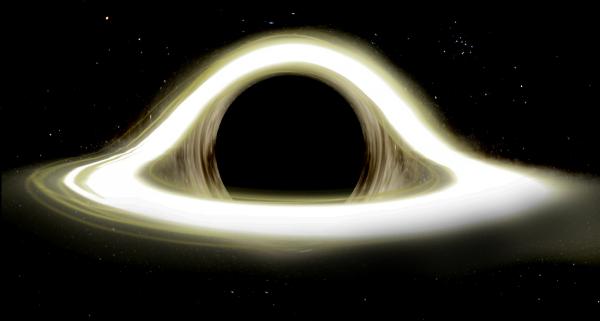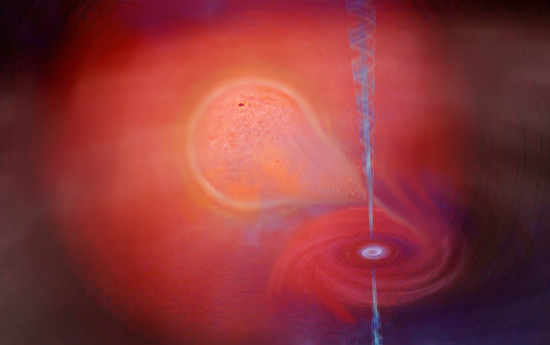BY LETTER
Black Hole
 Image from Steve Bowers |
Naturally occuring black holes
Any massive object (or region) in space that is so dense that within a certain radius, its gravitational field does not let anything, even light, escape. The term 'black hole' was coined for these objects by atomic age physicist John Archibald Wheeler.The radius at which a black hole becomes inescapable is known as the Schwarzschild radius and the distance from the hole's presumed center at which it becomes inescapable is known as the event horizon.
Most naturally-occuring black holes are formed from the collapse of a giant star in a supernova explosion. Stars with a mass over 3x that of Sol will inevitably pass at the end of their lifespan through the stages of red supergiant, supernova, and finally black hole. For a typical black hole with a mass of 10x Sol, the Schwarzschild radius is approximately 30 km. Any object falling into a stellar-mass (or smaller) black hole will be ripped apart by tidal forces before crossing the event horizon. Most black holes rotate, some rapidly, and rotational energy can be extracted from (or added to) the hole.
Black holes can be used to generate power for processing or other purposes via a number of methods, and may become useful sources of energy in the far future long after all the naturally-occurring stars have died. The process known as 'super-radiant scattering' can be used to convert the rotational energy of a black hole into luminosity; this method is sometimes known as a 'black hole bomb'.
Giant black holes at the centres of galaxies | |
 Image from Steve Bowers | |
| The Cormoran Supermassive Black hole, in NGC 6183, is surrounded by an alien civilisation. | |
Supermassive Black Holes
A supermassive black hole (SMBH) is the largest type of black hole, on the order of hundreds of thousands to billions of solar masses. SMBHs are found in the centre of almost all large galaxies; some have more than one such object, although these will almost certainly merge at some point in the future.Sagittarius A*, located in the core of the Milky Way galaxy, is a SMBH with a mass of 4.3 million solar masses (slightly small compared to others in comparable galaxies) which formed in the earliest period of the galaxy's existence.
Telescopic observations by the Argus Array and similar systems have found that galactic supermassive black holes are often the site of considerable activity by xenosophont civilisations, and are sometimes surrounded by various kinds of megastructure or other remnants of intelligent construction. The Cormoran SMBH for example is embedded in an artificial accretion disk which provides light and heat for a large swarm of planets. Some supermassive black holes in distant galaxies are believed to be a source of power for local civilisations, perhaps extracting rotational energy via superradiance; others may use metric engineering to convert the black hole itself into a black hole brain.
Artificial black holes
Small artificial black holes have been regularly created since the late First Federation Age. Black holes can be made in various ways, such as- using a very powerful explosion to implode an asteroid or small moon,
- striking a very small target from multiple directions with long, thin, very dense impactors at speeds close to the speed of light,
- collapsing a mass of magmatter,
- imploding a wormhole,
- blowing up a massive star, or
- using the same space-time metric technology that generates wormholes to warp space in a somewhat different manner to get a black hole.
Methods 1 and 2 are within the means of modosophont technology, while all the other options require transapientech.
Artificial black holes are much smaller than the stellar-mass holes usually encountered in nature. They can be made large enough to be stable over relatively long periods, or so small that they evaporate rapidly through Hawking radiation. They have many important industrial uses, including power generation in Hawking's Knots, artificial nucleosynthesis in Deep Well Industrial Zones, the production of gravity wells for artificial planets, and enhanced space-time curvature generation for various purposes.
 Image from Steve Bowers | |
| A black hole in orbit around a red giant | |
Related Articles
Appears in Topics
Development Notes
Text by M. Alan Kazlev, with comments by Todd Drashner
Hawking Radiation Calculator (original) by Xaonon / (current) by Viktor T. Toth
Initially published on 08 October 2001.
Hawking Radiation Calculator (original) by Xaonon / (current) by Viktor T. Toth
Initially published on 08 October 2001.
Additional Information
Useful Tool
Hawking Radiation Calculator Tool
Black hole bombs explained
Black hole bomb
Hawking Radiation Calculator Tool
Black hole bombs explained
Black hole bomb






